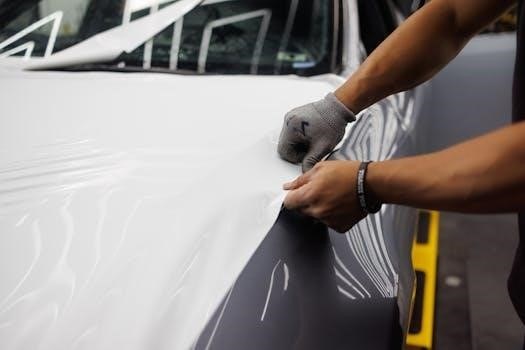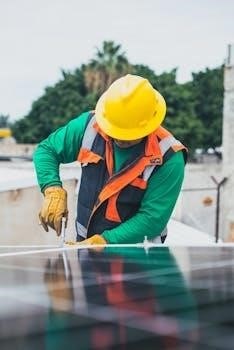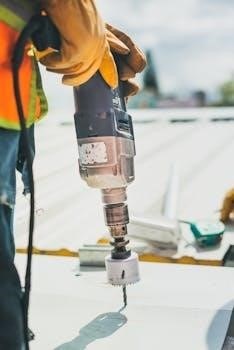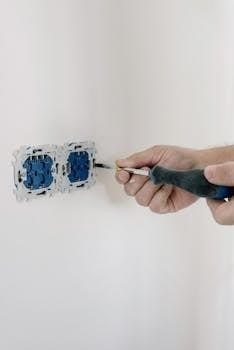Honeywell TH5220D1003 Installation Manual PDF⁚ A Comprehensive Guide
Welcome! This guide simplifies installing your Honeywell TH5220D1003 thermostat. Whether you’re experienced or new, we provide clear instructions. Access the complete PDF manual online for wiring, settings, and troubleshooting. Ensure successful installation and enjoy optimal home comfort with this resource.
The Honeywell TH5220D1003 FocusPRO 5000 is a non-programmable digital thermostat designed for ease of use and reliable performance. This thermostat is suitable for a variety of heating and cooling systems, offering a straightforward interface for temperature control. With its clear display and simple button layout, users can easily adjust settings to maintain a comfortable environment.
This model supports both battery and system power, providing flexibility during installation. It’s commonly used in residential settings and compatible with gas-fired unit heaters, duct furnaces, and other HVAC systems. The TH5220D1003 is known for its accuracy and dependability, ensuring consistent temperature management.
The thermostat also features installer setup options, allowing professionals to configure it to match specific system requirements. These settings include system type selection and other customizable features. The Honeywell TH5220D1003 offers a balance of simplicity and functionality, making it a popular choice for homeowners seeking a reliable temperature control solution without complex programming.
Its design prioritizes user-friendliness, ensuring effortless operation and maintenance. For detailed instructions and advanced settings, refer to the comprehensive installation manual.
Understanding the Manual’s Purpose
The Honeywell TH5220D1003 installation manual serves as a comprehensive guide for installing, wiring, and configuring the thermostat. It is designed to provide clear, step-by-step instructions for both experienced technicians and homeowners. The manual aims to ensure a safe and successful installation process, preventing potential issues and optimizing thermostat performance.
It covers essential topics such as safety precautions, wiring diagrams, and installer setup options. By following the manual, users can properly connect the thermostat to various heating and cooling systems, including gas-fired unit heaters and duct furnaces. The manual also includes troubleshooting tips for common issues that may arise during or after installation.
Furthermore, it details how to access and adjust thermostat settings to match specific system requirements. This ensures that the thermostat operates efficiently and effectively. The manual’s primary goal is to empower users with the knowledge and guidance needed to install and maintain the Honeywell TH5220D1003 thermostat correctly.
Ultimately, the manual facilitates a seamless installation experience, reducing the likelihood of errors and maximizing the thermostat’s lifespan and functionality. It acts as a vital resource for anyone seeking to understand and utilize the full potential of their Honeywell thermostat.
Safety Precautions Before Installation
Prior to commencing any installation work on the Honeywell TH5220D1003 thermostat, adhering to strict safety precautions is paramount. Begin by disconnecting the power supply to both the heating and cooling systems at the circuit breaker or fuse box to prevent electrical shock. Verify that the power is off using a reliable voltage tester before proceeding.
Ensure that all wiring conforms to local building codes and the National Electric Code ANSI/NFPA 70, latest edition. In Canada, wiring must comply with CSA C22.1, Part 1, Electrical Code. Ground the unit electrically in accordance with these codes.
Carefully inspect the thermostat and wiring for any signs of damage before installation. Do not install a damaged thermostat. If any existing wiring is frayed or worn, replace it immediately. Use appropriate tools and wear safety glasses to protect your eyes from debris.

When working with gas-fired unit heaters or duct furnaces, ensure that the gas supply is shut off before disconnecting or reconnecting any components. If you are not comfortable working with gas lines, consult a qualified HVAC technician. Always follow the manufacturer’s instructions and guidelines to avoid potential hazards.
By taking these safety precautions, you can minimize the risk of injury or damage during the installation process, ensuring a safe and successful outcome.
Wiring Requirements and Diagrams
Proper wiring is crucial for the Honeywell TH5220D1003 thermostat to function correctly. Before connecting any wires, consult the wiring diagrams provided in the installation manual to identify the correct terminals for your specific heating and cooling system. These diagrams cater to various configurations, including gas unit heaters, duct furnaces, and heat pump systems.
Ensure that the wires are properly stripped and connected securely to the thermostat terminals. Use the appropriate gauge wire for the connections, adhering to local electrical codes. Loose or improperly connected wires can cause malfunctions or even pose a fire hazard.
For systems with both heating and cooling, typically you’ll find connections for R (power), W (heating), Y (cooling), and G (fan). Some systems may require additional connections for heat pumps or auxiliary heat. Carefully match the wires from your existing thermostat to the corresponding terminals on the TH5220D1003.
If you are replacing an older thermostat, label each wire before disconnecting it to avoid confusion during the installation process. If unsure about any wiring connections, consult a qualified HVAC technician to ensure correct and safe installation. Double-check all connections before restoring power to the system.
Refer to the detailed wiring diagrams in the manual to avoid any errors that could damage the thermostat or your HVAC system.
Wiring Diagram Selection
Selecting the correct wiring diagram is paramount for the successful installation of your Honeywell TH5220D1003 thermostat. The installation manual contains multiple diagrams, each tailored to specific heating and cooling system configurations. Identifying your system type is the first step in choosing the appropriate diagram.
Consider factors such as whether you have a conventional furnace, a heat pump, or a dual-fuel system. Note the number of wires connected to your existing thermostat. A conventional system typically has fewer wires than a heat pump. The wiring diagram must match your system’s specific setup to ensure proper functionality.
Carefully compare your existing thermostat wiring to the diagrams provided. Look for matches in wire colors and terminal designations (e.g., R, W, Y, G, C). If your system has a “C” wire (common wire), it simplifies installation and improves thermostat performance, but it may not be present in all systems.
If you’re unsure which diagram to use, consult a qualified HVAC technician. Incorrect wiring can damage your thermostat or heating/cooling equipment. The manual provides guidance, but professional assistance can prevent costly mistakes. Verify the selected diagram accurately represents your system before proceeding with the wiring process. Double-check everything!
Always disconnect power to your HVAC system before making any wiring connections.
Step-by-Step Installation Guide
This guide provides a detailed walkthrough for installing your Honeywell TH5220D1003 thermostat. Before starting, gather necessary tools⁚ a screwdriver, wire stripper, and possibly a level. Ensure the power to your HVAC system is turned off at the breaker to prevent electrical shock.
Begin by removing your old thermostat. Carefully detach it from the wall plate, noting the wire connections. Label each wire with the corresponding terminal designation (e.g., R, W, Y, G) using the provided stickers or masking tape and a pen. This is crucial for reconnecting the wires correctly to the new thermostat.
Next, mount the new Honeywell thermostat’s wall plate to the wall. Use the included screws and anchors if needed. Ensure the wall plate is level for accurate temperature readings. Connect the wires to the corresponding terminals on the new wall plate, matching the labels you created earlier. Securely tighten the screws to hold the wires in place.
Attach the thermostat to the wall plate. Most models simply snap into place. Restore power to your HVAC system at the breaker. Follow the installer setup and configuration steps in the manual to program the thermostat to your specific heating and cooling system. Test the thermostat to ensure it’s functioning correctly.
Mounting the Thermostat
Properly mounting your Honeywell TH5220D1003 thermostat is crucial for accurate temperature sensing and overall performance. The thermostat should be installed on an interior wall, about five feet (1.5 meters) above the floor, in a location with good air circulation and average temperature. Avoid areas near drafts, direct sunlight, or heat sources like lamps or appliances, as these can affect temperature readings.

Before mounting, ensure the wall surface is clean, dry, and free of any obstructions. Use the provided mounting template to mark the screw locations on the wall. If necessary, use a level to ensure the template is straight. Drill pilot holes at the marked locations, using appropriate drill bit size for the wall material. Insert wall anchors if mounting to drywall or plaster.
Position the thermostat’s backplate or mounting plate against the wall, aligning the screw holes with the drilled pilot holes or wall anchors. Secure the backplate to the wall using the provided screws. Tighten the screws firmly, but avoid over-tightening, which could damage the backplate or the wall. Once the backplate is securely mounted, you can proceed with connecting the wiring and attaching the thermostat body.
Connecting Wires to the Thermostat
Connecting the wires correctly to your Honeywell TH5220D1003 thermostat is vital for its proper operation. Before starting, ensure the power to your heating and cooling system is turned off at the circuit breaker to prevent electrical shock. Carefully strip the insulation from the ends of each wire, exposing about 1/4 inch of bare wire.
Refer to the wiring diagram in the installation manual to identify the correct terminal for each wire. The terminals are typically labeled with letters corresponding to the different functions, such as R (power), W (heat), Y (cool), G (fan), and C (common). Loosen the screw on each terminal and insert the corresponding wire, ensuring a secure connection.
Tighten the screws firmly, but avoid over-tightening, as this could damage the terminals or the wires. Gently tug on each wire to verify that it is securely fastened. If any wires are loose, re-tighten the screws. Once all the wires are connected, carefully tuck any excess wire back into the wall opening. Double-check all connections against the wiring diagram before proceeding to the next step.
Installer Setup and Configuration
The Installer Setup and Configuration menu on the Honeywell TH5220D1003 thermostat allows you to customize the thermostat’s operation to match your specific heating and cooling system. Access this menu by following the instructions in the installation manual, typically involving pressing and holding a specific button combination.
Within the Installer Setup, you can configure various parameters such as the system type (heat pump, conventional, etc.), the number of heating and cooling stages, and the fan control settings. Carefully review each setting and select the option that corresponds to your equipment.
Incorrect settings can lead to inefficient operation or even damage to your system. The manual provides detailed explanations of each setting and recommended values for different system configurations. Pay close attention to the cycle rate settings, which determine how frequently the thermostat cycles the heating and cooling equipment. Adjust these settings to optimize comfort and energy efficiency. Once you have configured all the settings, save your changes and exit the Installer Setup menu.
Setting System Type
Configuring the correct system type in your Honeywell TH5220D1003 thermostat is crucial for proper operation. Access the Installer Setup menu, consult your manual for the specific button combination, and navigate to the system type setting. Common options include heat pump systems, conventional heating and cooling, and heat-only or cool-only configurations.
Selecting the wrong system type can cause operational issues, such as the thermostat not activating the correct heating or cooling components. If you have a heat pump, ensure the thermostat is configured accordingly to utilize its heating and cooling capabilities efficiently. For conventional systems, specify whether you have a gas furnace, oil furnace, or electric furnace. If you’re unsure of your system type, consult your HVAC equipment documentation or contact a qualified technician.
After selecting the appropriate system type, verify that the thermostat is controlling your heating and cooling equipment as expected. Test the heating and cooling functions to ensure they are working correctly and that the thermostat is responding to temperature changes. This step is essential for a comfortable home environment.
Programming the Thermostat
The Honeywell TH5220D1003 is a non-programmable thermostat, meaning it doesn’t support setting up automated temperature schedules. Instead, you manually adjust the temperature settings as needed. While this offers simplicity, understanding how to effectively manage these manual settings is essential for comfort and energy savings.

To adjust the temperature, use the up and down buttons on the thermostat. Observe the displayed setpoint temperature, which represents your desired indoor temperature. Increase the setpoint for warmer temperatures and decrease it for cooler ones. For heating, the thermostat will activate your heating system when the room temperature drops below the setpoint. For cooling, it will activate your cooling system when the room temperature rises above the setpoint.
Consider adjusting the temperature based on occupancy. Lower the heat or raise the cooling when you’re away, and adjust it to comfortable levels when you’re home. While it requires manual intervention, this approach can still contribute to significant energy savings compared to maintaining a constant temperature.
Troubleshooting Common Issues
Encountering problems with your Honeywell TH5220D1003 thermostat? Let’s explore some common issues and their solutions. If the thermostat display is blank, first check the batteries. Replace them with fresh ones, ensuring correct polarity. If the display remains blank, inspect the wiring connections to confirm they are secure and properly connected.
If the heating or cooling system isn’t responding, verify that the system switch is in the correct mode (Heat, Cool, or Off). Also, check the breaker for your HVAC system to ensure it hasn’t tripped. A wiring issue, like loose connections or incorrect wiring, could also be the culprit. Refer to the wiring diagrams in the installation manual to ensure everything is correctly connected.
If the thermostat is displaying an incorrect temperature, ensure it’s mounted away from direct sunlight or heat sources. A miscalibration can also cause inaccurate readings. If problems persist, consult a qualified HVAC technician for assistance. Remember, safety is paramount; always disconnect power before working on any electrical components.
Accessing the Complete PDF Manual Online

To gain a deeper understanding of your Honeywell TH5220D1003 thermostat and its capabilities, accessing the complete PDF manual online is highly recommended. This comprehensive resource contains detailed information on installation, wiring diagrams, programming features, and troubleshooting tips, ensuring you have all the necessary knowledge at your fingertips.
Finding the manual is simple. Start by visiting the official Honeywell Home website or searching for “Honeywell TH5220D1003 installation manual PDF” using your preferred search engine. Numerous websites offer the manual for download, including online manual repositories and product support pages.
Once you’ve located the PDF, you can view it directly in your web browser or download it for offline access. Having a digital copy of the manual allows you to quickly reference specific sections, zoom in on wiring diagrams, and easily search for keywords or topics of interest. Take advantage of this valuable resource to maximize your thermostat’s potential and ensure proper operation.
